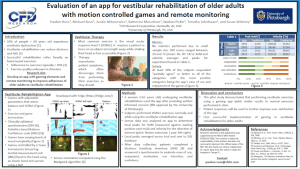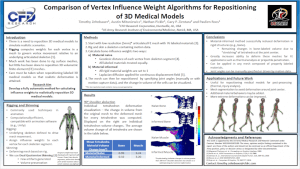CFD Research is excited to present their research on vestibular rehabilitation and medical model animation at the Annual meeting of the American Society of Biomechanics, which is being held virtually this year. The CFD Research Biomechanics Team will be presenting two posters highlighting results from their recent projects. Since this event is “virtual” you are welcome to review the posters and the narratives as well.
Poster #1: Evaluation of an app for vestibular rehabilitation of older adults with motion controlled games and remote monitoring
The CFD Research Biomechanics team has developed an app that uses motion sensor-controlled computer games to perform vestibular rehabilitation exercises to help reduce dizziness. The goal is to increase patient compliance by making rehabilitation more fun, as currently only about 50% of patients stick to their prescribed at-home exercise plan. The poster presents testing results of the app that was performed at the University of Pittsburgh on vestibular patients. During testing, the team found that the games effectively replicated the movements performed during conventional therapy, and patients generally found the games more enjoyable than standard exercises.
Watch Austin Mituniewicz provide a narrative of the Vestibular Rehabilitation poster here.
This work was funded by the National Institutes of Health (R43DC017408) and performed in collaboration with the University of Pittsburgh and the James A. Haley VA Hospital in Tampa FL.
Poster #2: Comparison of Vertex Influence Weight Algorithms for Repositioning of 3D Medical Models
The CFD Research Biomechanics team has developed software to reposition static 3D medical models of complete human internal anatomy. In the ASB poster, the team presents results from a comparison of two animation-inspired methods repositioning the 3D models: a material-naïve method that repositions all materials uniformly, and a material-informed method that attempts to eliminate deformation of rigid material such as bone. Applications of this software include real-time anatomy visualization for augmented reality applications, generating posed avatars for thermal analysis or protective equipment design, or for producing simulated military missions.
Listen to Tim Zehnbauer discuss the Repositioning poster here.
This work was funded by the US Army Medical Research and Materiel Command (W81XWH-18-C-0100) and performed in collaboration with NJIT.
To learn more about these projects and other exciting ongoing work in the CFD Research Biomechanics team, check out these other links:
Theraplay: Individualized game-based physical therapy for telemedicine
CoBi-Dyn: Interactive 3D Computational BioDynamics Software








